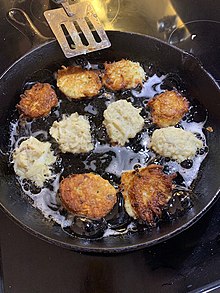Latke
 A latke frying | |
| Alternative names | Levivot, latka, potato pancake |
|---|---|
| Type | Fritter |
| Region or state | Central and Eastern Europe |
| Serving temperature | Hot, traditionally with sour cream or applesauce |
| Main ingredients | Potatoes, onion, egg, matzo meal, kosher salt, cooking oil |
A latke (Yiddish: לאַטקע latke; sometimes romanized latka, lit. "pancake") is a type of potato pancake or fritter in Ashkenazi Jewish cuisine that is traditionally prepared to celebrate Hanukkah.[1]
Etymology
[edit]The word comes from the Yiddish latke, itself from the East Slavic oladka, a diminutive of oladya 'small fried pancake', which in turn is from Hellenistic Greek ἐλάδιον eládion, '(olive) oil', diminutive of Ancient Greek ἔλαιον élaion, 'oil'.[2][3]

Its Modern Hebrew name, levivah (לְבִיבָה levivá), plural levivot, is a revival of a word used in the Book of Samuel to describe a dumpling made from kneaded dough, part of the story of Amnon and Tamar.[4] Some interpreters have noted that the homonym levav (לֵבָב leváv) means "heart", and the verbal form of l-v-v (ל־ב־ב l-b-b) occurs in the Song of Songs as well.
History
[edit]Some version of latkes goes back to at least the Middle Ages.[5] They were likely made of cheese (probably either ricotta or curd cheese), fried in poppyseed oil or butter, and served with fruit preserves. These cheese latkes were the most common kind of latke in Ashkenazi communities until the 19th century when the potato arrived in eastern Europe.[5][6][7]At the time, the cheapest and most readily available cooking fat was schmaltz, rendered poultry fat (usually from a goose or chicken), and due to Jewish dietary laws, which prohibit the mixing of meat and dairy products, alternatives to the cheese latke were introduced. These included buckwheat, rye flour, or root vegetables endemic to the region, such as turnips.[7] As the potato became popular in eastern Europe, it was quickly adopted to the point that today, latke is almost synonymous with potatoes.[5]
The latke is traditionally prepared during the Hanukkah holiday to commemorate the miracle of the oil in the Jewish Temple in Jerusalem lasting eight days.[8]
Variations
[edit]
Latkes today are most commonly made with potatoes, although other vegetables are also sometimes used. There are two main varieties: those made with grated potato and those made with puréed or mashed potato. The textures of these two varieties are different.
Grated potato version
[edit]Latkes made of grated potatoes are popular. They are prepared by grating potatoes and onions with a box grater or food processor; then, excess moisture is squeezed out. The grated potatoes are then mixed with eggs and flour or matzo meal; a vegan version uses chickpea flour and potato starch instead of eggs. The latkes are fried in batches in an oiled pan. The thickness is a matter of personal preference.
Puréed potato version
[edit]The dough for puréed potato latkes is puréed in a food processor. This form of latke is easier to shape and has a "pudding-like consistency".[9]
Other variations
[edit]Before the potato, latkes were and in some places still are, made from a variety of other vegetables, cheeses, legumes, or starches.[10][11] Modern recipes often call for the addition of onions and carrots.[12][13] Other versions include zucchini, sweet onion, gruyere (for french onion flavor), and sweet potatoes.[14] Sephardi Jews make latkes with zucchini and garlic (mücver), omitting dairy-based toppings (yogurt) when served as a side for roasts or meat.[15] Latkes are often served with either sour cream or applesauce.
See also
[edit]- Ijjeh – Middle Eastern dish of creamed egg mixed with greens (sometimes cooked like latkes)
- Fritas de prasa – Sephardic Jewish leek fritters
- Hush puppy – Deep-fried savory food made from cornmeal batter
- Latke–Hamantash Debate – Annual debate at the University of Chicago
References
[edit]- ^ Koenig, Leah (17 March 2015). Modern Jewish Cooking: Recipes & Customs for Today's Kitchen. Chronicle Books. p. 119. ISBN 9781452132327. Retrieved 22 December 2015.
- ^ Oxford English Dictionary, 3rd edition, December 2019, [s.v. https://www.oed.com/view/Entry/106171]
- ^ Vasmer, Maksimilian Romanovich (1973) [1958]. Etimologichesky slovar russkogo yazyka (Этимологический словарь русского языка) [Russian Etymological Dictionary] (in Russian). Moskva: Progress.
- ^ DLC (18 December 2006). "Analysis of the word "latke"". Balashon. Retrieved 25 December 2011.
- ^ a b c Marks, Gil (17 November 2010). "Latke". Encyclopedia of Jewish Food. Houghton Mifflin Harcourt. p. 707. ISBN 978-0544186316. Retrieved 22 December 2015.
- ^ Goodman, Matthew (23 November 2001). "On Chanukah, Cheese Was the Norm, But Then Came the Potato". Forward. Archived from the original on 7 September 2005. Retrieved 30 May 2017.
- ^ a b Wex, Michael (12 April 2016). Rhapsody in Schmaltz: Yiddish Food and Why We Can't Stop Eating It. St. Martin's Press. ISBN 9781250071514.
- ^ "Behind the Hanukkah tradition of latkes - CBS News". www.cbsnews.com. 22 December 2019. Retrieved 5 December 2023.
- ^ Geller, Jamie. "Healthier Potato Kugel Recipe (Recipe for potato kugel, but she talks about this kind of latke later in the video)". Youtube. Archived from the original on 22 December 2021. Retrieved 8 October 2019.
- ^ Appelbaum, Yoni (11 December 2015). "Everything You Know About Latkes Is Wrong". The Atlantic. Retrieved 22 December 2015.
- ^ "What Are Latkes? Plus: A Simple Potato Latke Recipe". Chabad.org.
- ^ Rachael Ray, Quick Potato and Carrot Latkes, The Food Network, December 20, 2008.
- ^ Philip and Karen Selwyn, Potato-carrot-onion Latkes, rec.food.cuisine.jewish archives, Oct. 11, 1998, 1:00 AM.
- ^ "The only latke recipe video you'll ever need". JTA. 1 February 2019. Retrieved 1 February 2019.
- ^ Levy, Faye (26 September 2009). Faye Levy's International Jewish Cookbook. Grand Central Publishing. ISBN 9780446567251.

